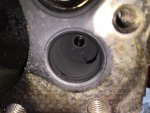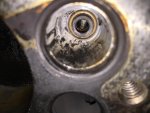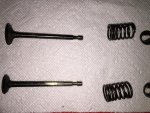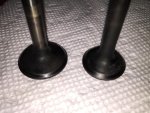You are using an out of date browser. It may not display this or other websites correctly.
You should upgrade or use an alternative browser.
You should upgrade or use an alternative browser.
Export thread
MTD push mower starts then stalls
#1
N
NBforge
N
NBforge
The other day my kid wanted to surprise me and do the first mow of the season before I got home. Problem- the mower had not yet been filled with oil. He ran it until it died out and wouldn't start. This is an MTD mower with a B&S 300 series motor. (MTD 11-020B029)
I came home and didn't realize the oil thing immediately. I cleaned the air filter and cleaned the carb and spark plug, and then finally checked/added oil. After all this I am able to get the mower to start but it will immediately stall out.
If I do nothing I get one start/stall and that's it. BUT if I turn the blade a rotation or 2 it will always start up on a single pull time and time again. It seems that the rotation of the blade is related to the stall.
When rotating there is a spot that binds a bit (nothing grinding just not smooth movement) and at there is a quiet audible honk or forcing of air. I will add that it's not every time the binding occurs, sometimes I get a couple smooth turns.
Could anyone tell me any way to troubleshoot this? Or is there a high likelihood that some serious damage was done running with no oil like a bend rod or something else.
Thanks
I came home and didn't realize the oil thing immediately. I cleaned the air filter and cleaned the carb and spark plug, and then finally checked/added oil. After all this I am able to get the mower to start but it will immediately stall out.
If I do nothing I get one start/stall and that's it. BUT if I turn the blade a rotation or 2 it will always start up on a single pull time and time again. It seems that the rotation of the blade is related to the stall.
When rotating there is a spot that binds a bit (nothing grinding just not smooth movement) and at there is a quiet audible honk or forcing of air. I will add that it's not every time the binding occurs, sometimes I get a couple smooth turns.
Could anyone tell me any way to troubleshoot this? Or is there a high likelihood that some serious damage was done running with no oil like a bend rod or something else.
Thanks
#2
R
Rivets
R
Rivets
Very simple time to clean the carb, install a new float needle and seat, adjust the float level. I'll bet the part number is 398188, but take your engine numbers with you to the local dealer and have him double check. Here is the procedure I recommend and use.
Needle and seat replacement
Remove the carb, and then remove the float bowl. Check the float bowl jet (which is the bowl screw) and make sure the jets both horizontal and vertical are clean and open. Tip the carb upside down and remove the float pin and float with needle attached. Look in the float needle passage and you should see the red float seat at the bottom of the passage. This is where a #5 crotchet hook would come in handy as you need to remove this seat. If you have no hook, but compressed air, you can blow through the fuel inlet and try to pop the seat out. Put your thumb over the passage to prevent the seat from flying who knows where. No air or hook try bending a stiff paper clip to dig the seat out.
I would either give the carb a good 24 hour soaking or have it ultrasonically cleaned at this time.
With the seat out clean the passage way with carb cleaner. Now you must find a drill bit slightly smaller than the passage way, to be used to press in the new seat. Apply a very, very small amount of a very light lube to the new seat. 3-1 oil or lighter, to help seat it better. Carefully insert the new seat in the passage way with the rings on the seat down toward the carb body. Slowly and carefully force the seat down with the back end of the drill bit. Once it is seated, check to see that it did not flip and the rings are up. *Next check to make sure that the float does not have any liquid in it. *If it does, replace. *If everything looks correct, attach the new needle to the float and install with the float pin centered. It everything is correct, the float should seat level to the carb body, when looking at it upside down. If everything looks good reattach the float bowl, making sure that both the bowl gasket and the nut gasket seal properly. Reinstall on the engine and test unit. Remember to have patience and take your time. Good luck, but I don't think you'll need it.
PS: *On the side of some Tecumseh carbs you will find a plastic cover. *Under this cover will be an idle jet. *Remove it and check to see that the jet is open both horizontally and vertically. *You should be able to push the old float needle wire through the vertical opening.
Needle and seat replacement
Remove the carb, and then remove the float bowl. Check the float bowl jet (which is the bowl screw) and make sure the jets both horizontal and vertical are clean and open. Tip the carb upside down and remove the float pin and float with needle attached. Look in the float needle passage and you should see the red float seat at the bottom of the passage. This is where a #5 crotchet hook would come in handy as you need to remove this seat. If you have no hook, but compressed air, you can blow through the fuel inlet and try to pop the seat out. Put your thumb over the passage to prevent the seat from flying who knows where. No air or hook try bending a stiff paper clip to dig the seat out.
I would either give the carb a good 24 hour soaking or have it ultrasonically cleaned at this time.
With the seat out clean the passage way with carb cleaner. Now you must find a drill bit slightly smaller than the passage way, to be used to press in the new seat. Apply a very, very small amount of a very light lube to the new seat. 3-1 oil or lighter, to help seat it better. Carefully insert the new seat in the passage way with the rings on the seat down toward the carb body. Slowly and carefully force the seat down with the back end of the drill bit. Once it is seated, check to see that it did not flip and the rings are up. *Next check to make sure that the float does not have any liquid in it. *If it does, replace. *If everything looks correct, attach the new needle to the float and install with the float pin centered. It everything is correct, the float should seat level to the carb body, when looking at it upside down. If everything looks good reattach the float bowl, making sure that both the bowl gasket and the nut gasket seal properly. Reinstall on the engine and test unit. Remember to have patience and take your time. Good luck, but I don't think you'll need it.
PS: *On the side of some Tecumseh carbs you will find a plastic cover. *Under this cover will be an idle jet. *Remove it and check to see that the jet is open both horizontally and vertically. *You should be able to push the old float needle wire through the vertical opening.
#3
B
bertsmobile1
B
bertsmobile1
Chances are when it was running dry it knocked a bit off the cam & cam followers so check the valve clearances.
I get them in all the time with next to no oil in them and mostly it does little in the way of fatal damage.
Starts then dies on a fresh out of storeae mower usually is a buildup of crud ( or water ) in the float bowl so just enough fuel squeezes past to start but not enough to run.
Try changing your regime.
Drop the old dirty oil on your second last mow for the season & fill it with nice new clean oil in there over the winter.
I get them in all the time with next to no oil in them and mostly it does little in the way of fatal damage.
Starts then dies on a fresh out of storeae mower usually is a buildup of crud ( or water ) in the float bowl so just enough fuel squeezes past to start but not enough to run.
Try changing your regime.
Drop the old dirty oil on your second last mow for the season & fill it with nice new clean oil in there over the winter.
#4
N
NBforge
N
NBforge
Thanks for the info.
If the clearance is off, how do you go about adjusting for a flat head engine? Is it simply a matter of grinding the end to achieve the desired clearance?
If the clearance is off, how do you go about adjusting for a flat head engine? Is it simply a matter of grinding the end to achieve the desired clearance?
#5
B
bertsmobile1
Correct and a right royal PIA of a job it is too.
Too close grind the valve, too loose and it is grind the seat.
To do thi you have to remove the head so eyeball the bore before you do too much.
Then put some weight on the piston and rotate the engine if it "clicks" any where the big end is toast.
It should offer a little resistance as the valve springs start to compress but if you feel binding or resistance any where else the little end / crank is gone.
Normally in that case it is toss the engine, but sounds like you have a good kid so rebuilding the mower might be some quality father / son bonding time so make it worthwhile on a far more important level than just money.
B
bertsmobile1
Thanks for the info.
If the clearance is off, how do you go about adjusting for a flat head engine? Is it simply a matter of grinding the end to achieve the desired clearance?
Correct and a right royal PIA of a job it is too.
Too close grind the valve, too loose and it is grind the seat.
To do thi you have to remove the head so eyeball the bore before you do too much.
Then put some weight on the piston and rotate the engine if it "clicks" any where the big end is toast.
It should offer a little resistance as the valve springs start to compress but if you feel binding or resistance any where else the little end / crank is gone.
Normally in that case it is toss the engine, but sounds like you have a good kid so rebuilding the mower might be some quality father / son bonding time so make it worthwhile on a far more important level than just money.
#6
N
NBforge
N
NBforge
I appreciate the help.
There was absolutely zero clearance with both valves. As much as I'd love to do a rebuild, I'm needing something to cut the grass sooner rather than later. Is this issue something shops would take care of, or would a toss out also be recommended by them?
I guess worst case a new mower is in the works and there's a project in the future.
There was absolutely zero clearance with both valves. As much as I'd love to do a rebuild, I'm needing something to cut the grass sooner rather than later. Is this issue something shops would take care of, or would a toss out also be recommended by them?
I guess worst case a new mower is in the works and there's a project in the future.
#7
R
Rivets
R
Rivets
How old is this engine? Both valves having zero clearance is highly unusual on an L-head engine. If that is the case, it is not a costly repair for a good shop, but before going that route I would double check those clearances.
#8
B
bertsmobile1
Not when it has been run without oil.
IF you have the space, push it to the back of the shed and have a look at it latter.
It is about a 2 hour job if it is just some wear.
However it is also a two hour job if the engine is toast.
If the hard facing is worn off they will rapidly close up again so it will be good money after bad.
Worthwile to do yourself but not a job to be sent out.
If the mower is good then you can get a replacenment engine from one of the specialist remainer engine shops like Repower or Small Engine Warehouse.
B
bertsmobile1
How old is this engine? Both valves having zero clearance is highly unusual on an L-head engine. If that is the case, it is not a costly repair for a good shop, but before going that route I would double check those clearances.
Not when it has been run without oil.
IF you have the space, push it to the back of the shed and have a look at it latter.
It is about a 2 hour job if it is just some wear.
However it is also a two hour job if the engine is toast.
If the hard facing is worn off they will rapidly close up again so it will be good money after bad.
Worthwile to do yourself but not a job to be sent out.
If the mower is good then you can get a replacenment engine from one of the specialist remainer engine shops like Repower or Small Engine Warehouse.
#9
N
NBforge
I did not take the head off to check clearance, so instead of TDC I was just turning it til I had one valve open and checked the other, then changed it around. But I am pretty positive that if not exactly .000 they are both well below spec.
bertsmobile- I picked up an old lawn boy gas/oil mix last night so that will take care of the yard for the time being. At this point I do intend on doing this job with my son.
I guess the first step is removing the head, is there anything other than the basics I need to be aware of when doing this. Is gasket replacement necessary? Before going too far I will check the clearance again with the factory recommended way of .25" past TDC.
My other question relates to what is needed for this job. Do we need a different type of spring compressor than one used on OHVs?
N
NBforge
This mower/engine was purchased around 2003.How old is this engine?
I did not take the head off to check clearance, so instead of TDC I was just turning it til I had one valve open and checked the other, then changed it around. But I am pretty positive that if not exactly .000 they are both well below spec.
bertsmobile- I picked up an old lawn boy gas/oil mix last night so that will take care of the yard for the time being. At this point I do intend on doing this job with my son.
I guess the first step is removing the head, is there anything other than the basics I need to be aware of when doing this. Is gasket replacement necessary? Before going too far I will check the clearance again with the factory recommended way of .25" past TDC.
My other question relates to what is needed for this job. Do we need a different type of spring compressor than one used on OHVs?
#10
M
motoman
M
motoman
If it seems effort-worthy the valve tips are ground on a machine to obtain true flatness. An old trick was to set such a valve in a bucket of water with just the tip exposed and heat cherry red . Then tip valve into water for quench. It worked for me many moons ago. Check tip for hardness with file.
#11
B
bertsmobile1
B
bertsmobile1
The real deal Briggs compressor makes things a bit easier.
The inlet & exhaust have different retainers.
One has a keyhole in the spring colar so you just compress the spring a little then push it back .
You can do this with a pair of long pointy nose pliers, or a couple of thick screwdrivers or the V end of a wrecking bar.
The other will either have a pin or regular collets.
You can work around, just depends on how much time you have and what sort of educational event you wish to make of it.
I always replace gaskets, they are about $ 5.00 for the head gasket or $ 15 for the full kit.
Just like a car head, start from the centre and loosen off the bolts 1/6 turn each in a criss cross manner then a second 1/6 th turn by which time ther should be almost no tension in the bolts.
I face down the ends of the valves with an oil stone.
It is a little tedious but you don't overshoot then have to machine down the seats which are a lot harder to compensate.
Briggs give you a clearence both with springs and without springs and I generally find the maxium clearance without springs brings fairly well in the middle of the clearence range with springs.
Good luck.
The inlet & exhaust have different retainers.
One has a keyhole in the spring colar so you just compress the spring a little then push it back .
You can do this with a pair of long pointy nose pliers, or a couple of thick screwdrivers or the V end of a wrecking bar.
The other will either have a pin or regular collets.
You can work around, just depends on how much time you have and what sort of educational event you wish to make of it.
I always replace gaskets, they are about $ 5.00 for the head gasket or $ 15 for the full kit.
Just like a car head, start from the centre and loosen off the bolts 1/6 turn each in a criss cross manner then a second 1/6 th turn by which time ther should be almost no tension in the bolts.
I face down the ends of the valves with an oil stone.
It is a little tedious but you don't overshoot then have to machine down the seats which are a lot harder to compensate.
Briggs give you a clearence both with springs and without springs and I generally find the maxium clearance without springs brings fairly well in the middle of the clearence range with springs.
Good luck.
#12
N
NBforge
N
NBforge
I cant tell you how much I appreciate you sharing the info, it makes the task a heck of a lot more approachable. For now we are waiting to get our spring compressor and gasket in the mail.
Managed to limp through getting the yard cut with the lawn boy I picked up but that too needs some TLC. I started with a new plug and sharpened blades but it still runs for a bit and then dies out. Im hoping a carb cleaning will get things right but the way that carb is stuffed in there is odd.
Managed to limp through getting the yard cut with the lawn boy I picked up but that too needs some TLC. I started with a new plug and sharpened blades but it still runs for a bit and then dies out. Im hoping a carb cleaning will get things right but the way that carb is stuffed in there is odd.
#13
N
NBforge
N
NBforge
In waiting for the spring compressor to arrive, the carb has been rebuilt and cleaned, fresh diaphragm. It looks like tomorrow will be the day to get going on everything.
For valve stem lubricant, do I really need to use one specific for mower engines? Or am I good just using a little of the oil I run in there?
For valve stem lubricant, do I really need to use one specific for mower engines? Or am I good just using a little of the oil I run in there?
#14
N
NBforge
N
NBforge
We have the valves and springs out. I had several questions at this point-
Is a green Scotch brite pad ok to use to clean the head and the valves?
The upper (intake) valve has a little resistance when you pull it out, is this ok? The valve is not bent, however I do see there is a little rubber collar sticking out of the chamber, whereas the other chamber this collar is flush with the opening. I am trying to attach pictures. Don't know if this is normal or not.
This valve had more carbon on it than the other so perhaps that too caused resistance.
I have only been able to find clearance specs with springs, any idea where to find them without? Model 09S0502 code 0520
Lastly, how free should the engine turn? It feels pretty firm in my option and stiffens as the piston reaches the top of the cylinder.




The first picture is the lower chamber and the second is the upper with the rubber collar sticking out
Is a green Scotch brite pad ok to use to clean the head and the valves?
The upper (intake) valve has a little resistance when you pull it out, is this ok? The valve is not bent, however I do see there is a little rubber collar sticking out of the chamber, whereas the other chamber this collar is flush with the opening. I am trying to attach pictures. Don't know if this is normal or not.
This valve had more carbon on it than the other so perhaps that too caused resistance.
I have only been able to find clearance specs with springs, any idea where to find them without? Model 09S0502 code 0520
Lastly, how free should the engine turn? It feels pretty firm in my option and stiffens as the piston reaches the top of the cylinder.




The first picture is the lower chamber and the second is the upper with the rubber collar sticking out
